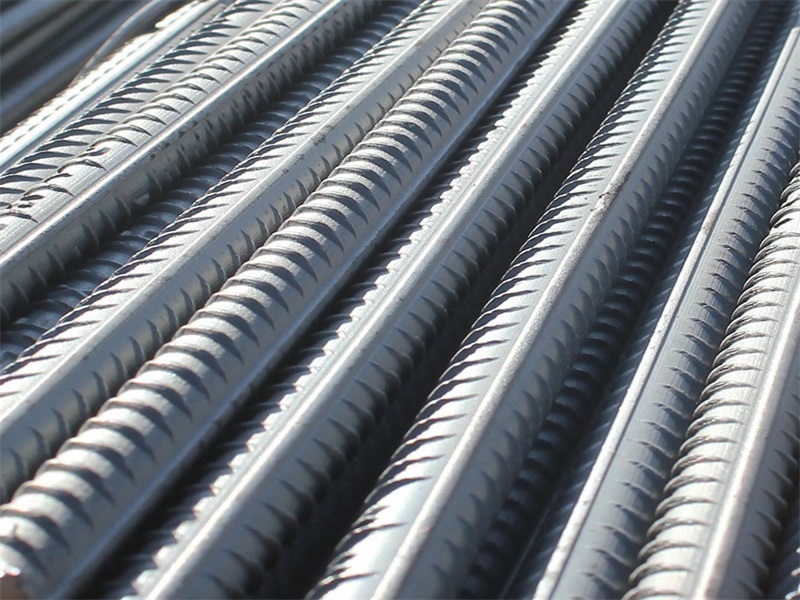Properties
| Chemical properties of carbon steel rebar | ||||||
| Grade | C | Si | Mn | P | S | carbon equivalent Ceq % |
HRB335 | ≤0.25 | ≤0.80 | ≤1.60 | ≤0.045 | ≤0.045 | ≤0.52 |
HRB400 | ≤0.25 | ≤0.80 | ≤1.60 | ≤0.045 | ≤0.045 | ≤0.54 |
HRB500 | ≤0.25 | ≤0.80 | ≤1.60 | ≤0.045 | ≤0.045 | ≤0.55 |
ASTM A615 GR 40 | ≤0.33 | ≤0.55 | ≤1.50 | ≤0.045 | ≤0.045 | |
ASTM A615 GR 60 | 0.38~0.45 | 0.20~0.40 | 1.20~1.60 | ≤0.045 | ≤0.045 | |
| Mechanical properties of carbon steel rebar | ||||
| Grade | Lower Yield Strength ReL MPa | Tensile Strength Rm MPa | Elongation after break A % | Total Elongation at maximum force Agt % |
HRB335 | ≥335 | ≥455 | ≥17 | ≥7.5 |
HRB400 | ≥400 | ≥540 | ≥16 | ≥7.5 |
HRB500 | ≥500 | ≥630 | ≥15 | ≥7.5 |
| Mechanical properties of ASTM A615 carbon steel rebar | ||||
| Grade | Yield Strength / MPa | Tensile Strength / MPa | Elongation / % | |
ASTM A615 GR 40 | ≥280 | ≥420 | 3#[10] | ≥11 |
| 4#[13]-6#[19] | ≥12 | |||
ASTM A615 GR 60 | ≥420 | ≥620 | 3#~6# | ≥9 |
| 7#~8# | ≥8 | |||
| 9#~12# | ≥7 | |||
| Bending properties of carbon steel rebar | ||
| Grade | Nominal diameter d(mm) | Bending head diameter |
HRB335 | 6~25 | 3d |
| 28~40 | 4d | |
| >40~50 | 5d | |
| HRB400 | 6~25 | 4d |
| 28~40 | 5d | |
| >40~50 | 6d | |
HRB500 | 6~25 | 6d |
| 28~40 | 7d | |
| >40~50 | 8d | |
| Carbon steel rebars shall be subjected to a bending test. After bending 180° with the diameter of the bending indenter, the bent surface of the carbon steel rebar must not produce cracks. | ||
Application
Hot-rolled ribbed steel bars, commonly known as rebar, usually have 2 longitudinal ribs and transverse ribs evenly distributed along the length. There are three shapes of transverse ribs: spiral, herringbone, and crescent. The current Chinese standard stipulates that it is crescent.
The carbon steel rebar mainly bears the tensile stress in the concrete, and due to the effect of the rib, it has a large bonding capacity with the concrete.
As an important steel for reinforced concrete, carbon steel rebar is an indispensable structural material.Widely used in housing, bridges, roads and other infrastructure and important energy, transportation and other engineering projects.As large as public facilities such as roads, railways, bridges, culverts, tunnels, flood control, and dams; as small as foundations, beams, columns, walls, and building panels.
Carbon steel rebar HRB335, HRB400 and HRB500 are all produced in accordance with the Chinese standard GB/T 1499.2-2018 "Steel for Reinforced Concrete Part 2: Hot Rolled Ribbed Steel Bars".
Rebar standard: ASTM A615/A615M.Steel type: Gr40, Gr60.For export, ASTM A615 GR 40 and ASTM A615 GR 60 carbon steel rebars are available in cut lengths ranging from 6-12 meters.American standard rebar is divided into Gr 40 (280MPa grade steel bar) and Gr 60 (420MPa grade steel bar) according to strength grade.
Dimensions, weight and tolerances
The nominal cross-sectional area and theoretical weight of carbon steel rebar are listed in the table:
Nominal Diameter mm | Nominal cross-sectional area mm2 | Theoretical Weighta kg/m |
| 6 | 28.27 | 0.222 |
| 8 | 50.27 | 0.395 |
| 10 | 78.54 | 0.617 |
| 12 | 113.1 | 0.888 |
| 14 | 153.9 | 1.21 |
| 16 | 201.1 | 1.58 |
| 18 | 254.5 | 2.00 |
| 20 | 314.2 | 2.47 |
| 22 | 380.1 | 2.98 |
| 25 | 490.9 | 3.85 |
| 28 | 615.8 | 4.83 |
| 32 | 804.2 | 6.31 |
| 36 | 1018 | 7.99 |
| 40 | 1257 | 9.87 |
| 50 | 1964 | 15.42 |
| a The theoretical weight is calculated based on the density of 7.85g/cm3. | ||
The allowable deviation between the actual weight and theoretical weight of carbon steel rebar is shown in the table:
Nominal Diameter mm | Deviation between actual weight and theoretical weight % |
| 6~12 | ±6.0 |
| 14~20 | ±5.0 |
| 22~50 | ±4.0 |





 Back to top
Back to top
 Free quotation
Free quotation
 Online Service
Online Service
 Scheme customization
Scheme customization
 Return to bottom
Return to bottom